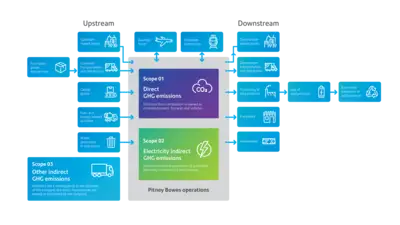What are scopes 1, 2, and 3, and why they are important to your long-term business
Climate change effects are all around us, whether through increased frequency and severity of natural disasters or harder-to-perceive background effects like change in average temperatures and precipitations.
At the same time, we feel the effects of new legislations for disclosure of businesses’ environmental performances and increased operational control, such as phasing out of combustion engine vehicles in many countries.
The scientific community has established a link between climate change and emissions of greenhouse gases (GHG) and its most known emission carbon dioxide (CO2) as a byproduct of the combustion of fossil fuel; for example, those from vehicle engines or a coal-burning power station. There are other gases like methane (CH4) that contribute to climate change, but these are often more significant for specific industry sectors like agriculture or chemicals.
This scientific theory is based on a link between climate change and the quantity of GHG emissions. Actions and limits are being discussed and agreed upon in international conferences such as Conferences of the Parties (COP). It’s therefore central to account for GHG emissions every year to gauge the progress toward international goals.
This is why there’s growing pressure and emphasis on disclosure. California’s new climate disclosure laws, Senate Bill (SB) 253 and 261, require large businesses to report emissions, and prepare climate-related financial risk disclosures. The proposed SEC rule could go in the same direction. Disclosure should not be seen as an end, but rather as an enabling tool to support and prepare the adaptation toward lower carbon societies—and this is where the concept of scopes 1, 2 and 3 becomes important.
Definitions
To estimate GHG emissions, the international community came up with ways to split emissions into three categories, or “scopes” that are defined as:
Scope 1: Direct GHG emissions
Direct GHG emissions occur from sources owned or controlled by the company (i.e., emissions from combustion in owned or controlled boilers, furnaces, vehicles, etc.).
Scope 2: Electricity indirect GHG emissions
Scope 2 accounts for GHG emissions from the generation of purchased electricity consumed by the company.i
Scope 3: Indirect emissions
All indirect emissions (not included in scope 2) that occur in the value chain of the reporting company, including both upstream and downstream emissions.ii
It’s important to precisely categorize the emissions to avoid double counting, as someone’s direct emissions could be someone else’s indirect emissions. For example, a logistic carrier’s scope 1 emission from its fleet of trucks is part of its clients’ scope 3 emissions.
Scope 3 is a way to leverage the influence of larger companies over their supply chain that might not fall within the scope of disclosure requirements because they are too small or based outside covered countries. Many companies, including Pitney Bowes, have scope 3 long-term targets that will incite them to work with their supply chain toward a common reduction goal.

Scope 3 can represent 90% of total emissions for many companies, especially retailersiii so if you move toward reporting your emissions, there’s a good chance that you’ll need to report on your scope 3 and you’ll need to estimate your suppliers’ emissions for your business.
Depending on categories like transportation or business travel, there are several ways to calculate your scope 3 emissions. Some are based on units of products or services bought, but quite often it’s based on using industry average emission factors per USD spent. Here’s an example: USD 1M spent in transportation would not produce the same amount of CO2 as USD 1M spent in procuring steel.
An improvement on this method is to ask your supplier for a report based on its real emissions.
This is exactly what Pitney Bowes has developed for its GEC clients. We can now offer you a breakdown of your CO2 emissions generated by the handling and transportation of all your parcels from end to end. This includes all transportation and warehouse operations from the moment the packages enter Pitney Bowes’ care to their delivery.
For more information, contact your usual Pitney Bowes point of contact or download the full ESG report.
iA Corporate Accounting and Reporting Standard https://ghgprotocol.org/corporate-standard
iiCorporate Value Chain (Scope 3) Accounting and Reporting Standard https://ghgprotocol.org/corporate-value-chain-scope-3-standard
iiiScope 3 Frequently Asked Questions https://ghgprotocol.org/sites/default/files/standards_supporting/Scope%203%20Detailed%20FAQ.pdf
